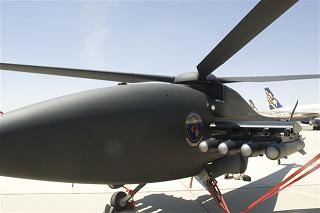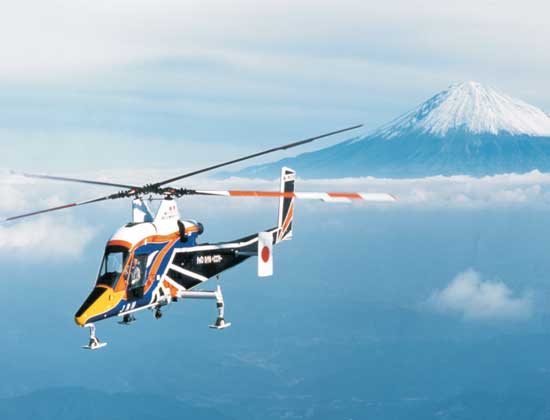Original URL: https://www.theregister.com/2009/08/13/jarhead_robochopper_finals/
US Marines' Afghan robocopter-supply contest down to two
Unmanned air haulage could be cheaper than trucks
Posted in Science, 13th August 2009 12:34 GMT
Ambitious plans by the US Marines which might reshape tomorrow's battlefields - and even upset civilian logistics in some circumstances - have moved ahead. A competition to select an unmanned aircraft for delivery of supplies to isolated outposts in Afghanistan by 2010 has now eliminated all but two contenders.

In the black corner ...
The original Marine Corps "IMMEDIATE CARGO UNMANNED AERIAL SYSTEM" plan called for manufacturers to step up with flying robots able to hover at high altitudes (for instance up in the Hindu Kush) and deliver ten tons of supplies across distances of 150 miles in 24 hours. The Marines specified that the gear had to be almost ready to go right away, as they wanted to be using it in the field by next year.
As regular Reg readers will know, there are in fact a few robot air vehicles out there potentially able to tackle such tasks. Our old friends the Fire Scout droid kill-chopper, the A160T Hummingbird unmanned whisper-copter and the MMIST SnowGoose robo motor'chute all came forward, as did an unmanned version of the Kaman K-MAX intermeshing-rotor whirlybird.
It has now been revealed that the Fire Scout is out, as is the SnowGoose. The latter, while it has already been used for Afghan resupply by US special forces, was perhaps always on a hiding to nothing. It is Canadian not US made, and it fails to meet the strict letter of the requirement as it can't hover. Makers MMIST had spoken of modifying the existing parawing, perhaps to gyrocopter configuration - and will no doubt have pointed out that the SnowGoose can lift off without trouble from a moving Humvee or ship - but evidently this didn't convince the Marines.
With the Fire Scout also out of the running for undisclosed reasons, that leaves the A160T and K-MAX - perhaps coincidentally the offerings from the two biggest US defence firms, Boeing and Lockheed.
The A160T is said to offer exceptional high-altitude performance, deriving from its cunning variable-speed rotor tech. It is also touted for its quietness, though this isn't a requirement in this context.
The K-MAX, already in widespread service as a manned chopper and lately touted in a robotised version by Lockheed, is also noted for its lifting ability. Its two intermeshing rotors avoid the need for a tail prop, channelling all its power into lift and letting it carry more than its own weight. The intermesh approach with two adjacent rotor hubs is said by its designers to be simpler than coaxial twin rotors as seen on some Russian machines and the Sikorsky X3 high-speed prototype.
The Marines have now given Boeing $500k and Lockheed $860k to further demo their robo-lifters, with a February deadline. The winning aircraft - assuming one or both actually shows it is ready for combat - will immediately be purchased in some numbers and sent to Afghanistan, where the Marines are now heavily engaged in the war-torn south alongside British and some other allied troops.
But why the sudden urgency?

Nice intermeshing rotors: but that human pilot is so old-fashioned
It's hoped that the new robo-lifters can reduce the risks and expense of resupplying troops in the field. Ground supply convoys in Afghanistan must be heavily guarded and nonetheless involve a lot of casualties from roadside bombs and ambushes. The expense of operating protected vehicles on the poor or nonexistent roads of Afghanistan is also very significant.
The alternative, using manned helicopters, involves less risk and less people - aircrews are normally under threat only during drop-offs, and not all that much even then. But manned helicopters are massively costly to run, and one of the main bottlenecks to their use just now is lack of expensive aircrew - the US defence secretary has recently assigned extra cash for training and manpower to get unused choppers into the air. Furthermore, Afghanistan's hot-and-high conditions are a very tough environment for helicopters, cutting into their lifting performance and meaning that the weight of a crew and associated bits and pieces - for instance armour protection, likely to be demanded even though the flyboys' risk is fairly small - becomes well worth getting rid of.
By contrast an unmanned helicopter needs no crew and involves no risks. It needn't have any armour. If supplies are urgently needed, it can be flown into the midst of a hot firefight without a qualm. You could cut corners on maintenance - a very significant cost - without any need to fret about possible dead aviators: instead you could trim procedures to save as much money as possible before the cost of crashes offset any further gain.
Considered overall in terms of blood and money, it seems quite possible - as some people involved are saying - that unmanned air resupply could be cheap compared not only to manned aircraft, but even compared to ground convoys. That would be a serious change to the face of battle.
One also notes that the K-MAX is already heavily used worldwide by logging and mining companies, or others who have to operate where roads are few or bad.
Nobody's saying that robocopters could beat trucks or trains on cost in the civilian world if a truck or train can do the job, of course. But building a road or a railway costs a lot of money. Some research suggests that the overall environmental impact of train+rails or truck+roads is more than that of aircraft.
If the Marines' idea catches on, the human race may sometimes choose in future - when developing and exploiting a new area - to use air lift from the start rather than covering a place with rails or road tar.
On the other hand, it just might be that robotising the trucks will prove more popular, in both military and civilian contexts. ®